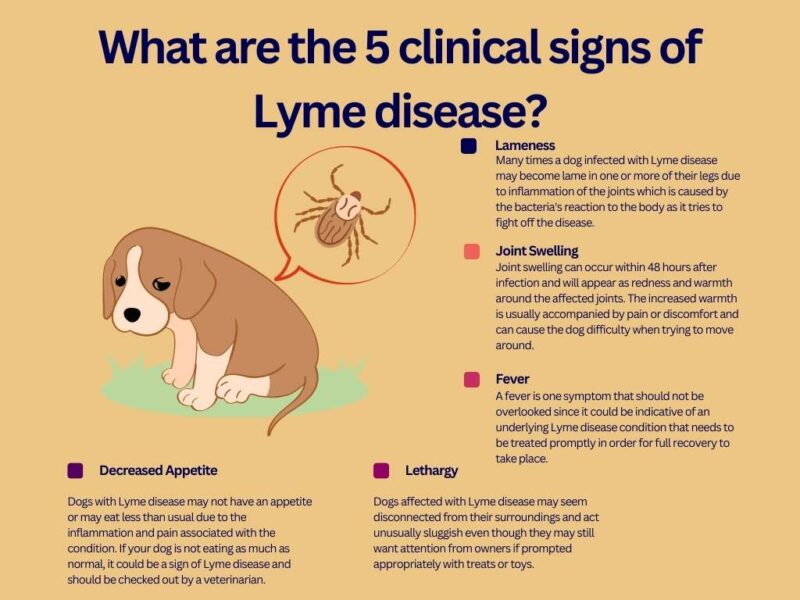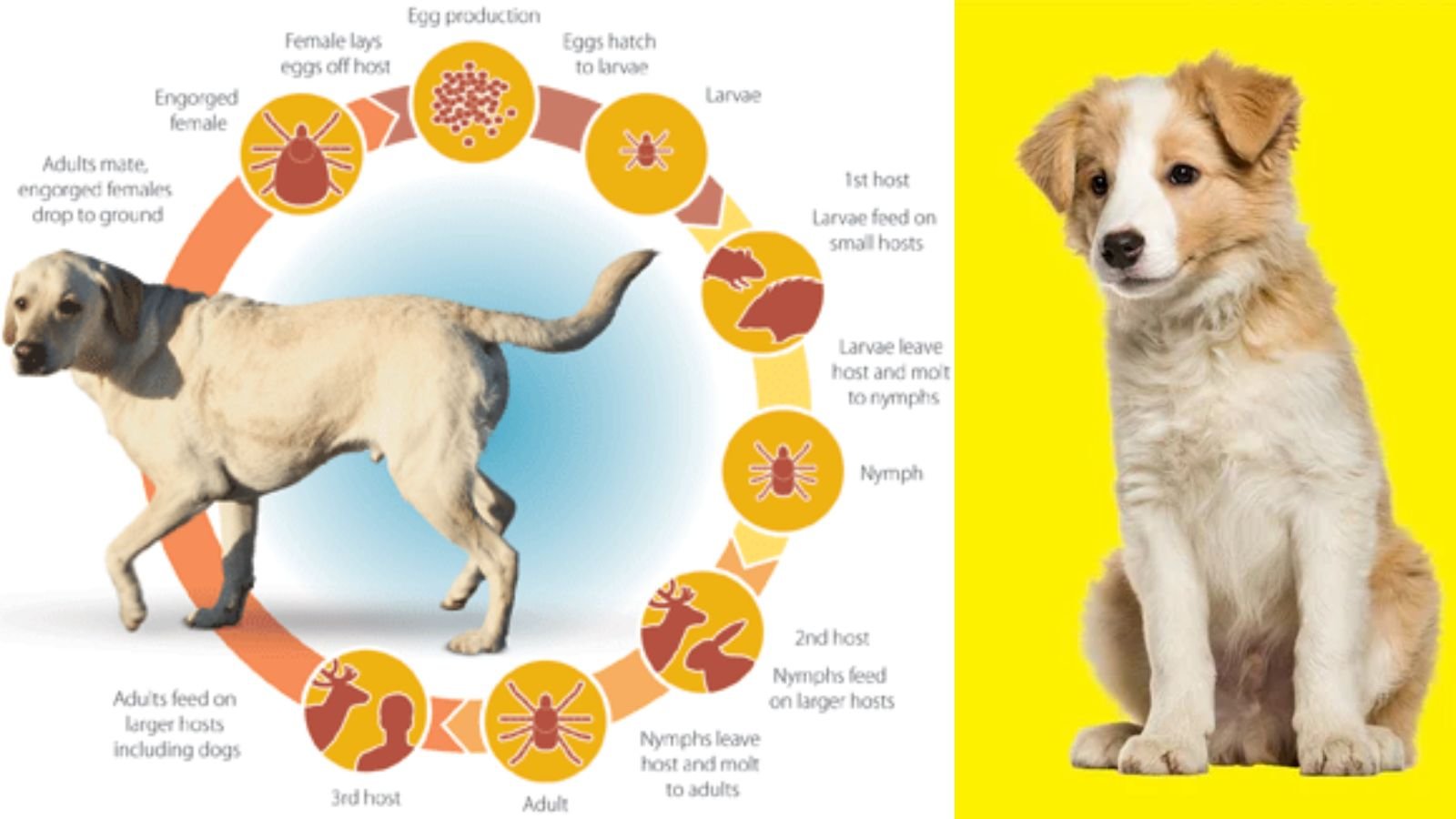Find out How to Know If Your Dog Has Lyme Disease. To know if your dog has Lyme disease, watch for symptoms like lameness, fever, and loss of appetite. Your vet can confirm with blood tests.
Lyme disease is a tick-borne illness that can affect dogs as well as humans. Understanding the signs and symptoms is crucial for early detection and treatment. If your dog spends time outdoors in areas with ticks, it’s important to be vigilant.
Lyme disease can lead to serious health issues if left untreated. Regular check-ups and preventive measures can help keep your furry friend safe and healthy. By being proactive, you can ensure your dog’s well-being and catch any potential health concerns early on.
Introduction To Lyme Disease In Dogs
Detecting Lyme disease in dogs involves watching out for symptoms like fever, lameness, and lethargy. Keep an eye on your pet for signs like swollen joints or loss of appetite. Regular tick checks and prompt vet visits are crucial for early detection and treatment.
The Tick-borne Threat To Canine Health
When it comes to Lyme disease in dogs, pet owners need to be aware of the serious threat posed by this tick-borne illness. Lyme disease is caused by the bacterium Borrelia burgdorferi, which is transmitted to dogs through the bite of infected black-legged ticks (Ixodes scapularis). These ticks are commonly found in wooded and grassy areas, making dogs who spend time outdoors particularly susceptible to Lyme disease.
It’s crucial for dog owners to understand the potential risks associated with Lyme disease and to take proactive measures to protect their pets from tick bites. By being vigilant and informed, dog owners can help safeguard their furry friends from this potentially debilitating illness.
Why Lyme Disease Awareness Is Crucial For Dog Owners
Lyme disease awareness is vital for dog owners because early detection and treatment are key to effectively managing the illness. Recognizing the symptoms of Lyme disease and understanding the importance of preventive measures such as tick control and vaccination can significantly impact a dog’s health and well-being.
By increasing awareness about Lyme disease, dog owners can take the necessary precautions to minimize the risk of tick bites and seek prompt veterinary care if their dog shows any signs of illness. This proactive approach can make a meaningful difference in protecting dogs from the potentially serious consequences of Lyme disease.

Credit: www.jerseyvets.co.uk
Recognizing Lyme Disease Carriers
Identifying Ticks That Transmit Lyme Disease
Identifying ticks that transmit Lyme disease is crucial for protecting your dog. The most common carrier of Lyme disease is the black-legged tick, also known as the deer tick. These ticks are typically small, ranging from the size of a poppy seed to a sesame seed, making them difficult to spot. They have a reddish-brown body and black legs, which is where they get their name from. When inspecting your dog for ticks, pay close attention to areas such as the ears, head, neck, and paws, as these are common areas for ticks to attach themselves.
Habitats And Seasons: When Your Dog Is At Risk
Understanding the habitats and seasons when your dog is at risk of encountering Lyme disease-carrying ticks is essential for prevention. These ticks thrive in wooded and grassy areas, especially in regions with dense vegetation. They are most active during the warmer months, from spring to fall. Therefore, it’s important to be extra vigilant during these times and avoid letting your dog roam in tall grass or heavily wooded areas.
Early Signs Of Lyme Disease In Dogs
Lyme disease, a tick-borne illness, can affect dogs. Recognizing the early signs is crucial for timely treatment.
Behavioural Changes To Watch For
- Increased lethargy and reluctance to move.
- Irritability or unexplained aggression.
- Decreased appetite or refusal to eat.
Physical Symptoms That Should Raise Alarm
- Lameness or stiffness in limbs.
- Swollen joints that are warm to the touch.
- Fever and fatigue.
If you observe these signs, consult your vet promptly for proper diagnosis and treatment.
The Clinical Symptoms Of Lyme Disease
Dog owners need to be aware of the clinical symptoms of Lyme disease, as early detection and treatment are crucial for the well-being of their furry companions. Recognizing these symptoms can help pet owners take prompt action and seek veterinary care when necessary. The following are some common clinical symptoms of Lyme disease in dogs.
Joint Pain And Limping In Affected Dogs
Joint pain and limping are among the primary indicators of Lyme disease in dogs. Affected canines may exhibit lameness in one or more limbs, often accompanied by swelling and tenderness in the joints. This can lead to a noticeable decrease in their mobility and overall activity levels.
Fever And Lethargy: More Than Just Tiredness
Dogs with Lyme disease may experience fever and lethargy that goes beyond normal tiredness. A persistently elevated body temperature, combined with a lack of energy and enthusiasm, could signal the presence of the disease. Dog owners need to monitor their pet’s overall behaviour and seek veterinary advice if they observe these symptoms.
Diagnostic Steps For Lyme Disease
When it comes to diagnosing Lyme disease in dogs, there are specific steps that veterinarians follow to confirm the presence of the illness. These diagnostic steps are crucial in identifying the disease early and initiating the appropriate treatment. Understanding these diagnostic steps can help dog owners recognize the signs and seek timely medical attention for their furry companions.
Blood Tests And Veterinary Diagnostics
Blood tests play a key role in diagnosing Lyme disease in dogs. Veterinarians often conduct a serologic test to detect the presence of antibodies against the bacteria that cause Lyme disease. This test can help determine if the dog has been exposed to the disease-causing bacteria. In addition, veterinary diagnostics may involve a thorough physical examination and assessment of the dog’s symptoms to complement the blood test results.
Understanding The Results And False Negatives
Understanding the results of blood tests and veterinary diagnostics is essential for dog owners. A positive result indicates the presence of Lyme disease, prompting immediate treatment. However, it’s important to note that false negatives can occur, especially during the early stages of the disease. False negatives may delay the diagnosis, leading to untreated Lyme disease in dogs. Therefore, close monitoring and retesting may be necessary if clinical suspicion remains high despite initial negative results.

Credit: www.youtube.com
Treatment Options For Lyme Disease
Detecting Lyme disease in dogs involves observing symptoms like lethargy, fever, and joint swelling. Treatment options typically include antibiotics and supportive care to alleviate discomfort and aid recovery. Early detection is crucial for successful management of Lyme disease in dogs.
Antibiotics And Medication Protocols
Antibiotics are the primary treatment for Lyme disease in dogs.
Common antibiotics include doxycycline, amoxicillin, and ceftriaxone.
Supportive Care And Pain Management
Supportive care involves providing rest, hydration, and proper nutrition.
Pain management includes medications like NSAIDs and opioids for comfort.
Preventing Lyme Disease In Dogs
Tick Prevention Strategies
To prevent Lyme disease in dogs, it’s crucial to implement effective tick prevention strategies. This includes regularly checking your dog for ticks after outdoor activities, especially in wooded or grassy areas. Utilize tick repellents and consider using tick control products recommended by your veterinarian to further reduce the risk of tick bites.
Vaccinations And Regular Vet Check-ups
Another essential aspect of preventing Lyme disease in dogs is ensuring they receive the necessary vaccinations and regular vet check-ups. Consult with your veterinarian about the appropriate vaccination schedule for your dog, including the Lyme disease vaccine. Regular check-ups allow for early detection and prompt treatment if your dog is exposed to ticks carrying the Lyme disease bacteria.
Long-term Management And Monitoring
Long-term management and monitoring are crucial for dogs with Lyme disease, especially those who have experienced chronic symptoms. It’s important to stay vigilant and proactive in overseeing your dog’s health to ensure they have the best quality of life possible.
Dealing With Chronic Lyme Disease
For dogs with chronic Lyme disease, a comprehensive treatment plan is essential. This may include long-term antibiotic therapy, anti-inflammatory medications, and supportive care to manage symptoms such as joint pain and fatigue.
Regular Bloodwork And Follow-up Visits
To effectively monitor your dog’s condition, regular bloodwork is necessary to assess their overall health and the effectiveness of the treatment. Follow-up visits with the veterinarian should be scheduled at appropriate intervals to discuss any changes in your dog’s condition and adjust the management plan as needed.
Understanding The Risks Of Co-infections
Lyme disease is not the only concern when it comes to tick bites. Ticks can transmit other harmful diseases such as Anaplasmosis and Ehrlichiosis, which can co-infect your dog.
Comprehensive care is crucial to address co-infections. Veterinarians recommend regular tick prevention, prompt removal, and thorough monitoring for symptoms of various tick-borne diseases.

Credit: beyondpets.com
Conclusion: Protecting Your Dog From Lyme Disease
Detecting Lyme disease in dogs can be challenging as it shares symptoms with other health conditions. Look out for signs such as lethargy, joint pain, fever, and loss of appetite. Preventing tick bites is the best way to protect your furry friend from this disease.
Key Takeaways For Dog Owners
To protect your dog from Lyme disease, it is important to be aware of the symptoms and take preventative measures. Key takeaways for dog owners include:
- Regularly checking your dog for ticks, especially after spending time outdoors
- Using tick prevention products recommended by your veterinarian
- Watching for symptoms such as lethargy, fever, and joint pain
- Seeking veterinary care if your dog displays symptoms or has been exposed to ticks
Staying Proactive In Your Dog’s Health
Preventing Lyme disease in your dog is just one aspect of staying proactive in their overall health. Other ways to keep your dog healthy include:
- Providing a balanced diet and regular exercise
- Scheduling routine veterinary check-ups and vaccinations
- Keeping your dog’s living environment clean and free of hazards
- Monitoring your dog’s behaviour and seeking veterinary care if you notice any changes
By staying proactive in your dog’s health, you can help prevent illnesses like Lyme disease and ensure your furry friend stays happy and healthy for years to come. Remember to always consult with your veterinarian for personalized recommendations and advice.
Frequently Asked Questions
How to Know If Your Dog Has Lyme Disease?
To know if your dog has Lyme disease, watch for symptoms like lameness, fever, and loss of appetite. Your vet can confirm with blood tests.
How Do You Detect Lyme Disease In Dogs?
Lyme disease in dogs is detected through blood tests, clinical signs, and physical exams by veterinarians.
Can A Dog Recover From Lyme Disease?
Yes, with prompt treatment, dogs can recover from Lyme disease. Medication and supportive care help alleviate symptoms.
What Are The Three Stages Of Lyme Disease In Dogs?
The three stages of Lyme disease in dogs are: early localized, early disseminated, and late disseminated. In the early localized stage, symptoms may include lameness and fever. The early disseminated stage may involve heart and nervous system issues. The late disseminated stage can lead to kidney and joint problems.
What Are The Chances My Dog Has Lyme Disease?
The chances of your dog having Lyme disease depend on their exposure to ticks. Regular prevention measures can help lower the risk significantly.
Conclusion
Lyme disease is a serious health concern for both dogs and humans alike. As a pet owner, being aware of the signs and symptoms of the disease is crucial for early detection and treatment. By regularly checking your dog for ticks, keeping them on tick prevention medication, and seeking veterinary care if you suspect they may have Lyme disease, you can help keep your furry friend healthy and happy.
Remember, prevention is key, so take the necessary steps to protect your dog from this potentially debilitating disease.

Hello I am Farhana I have been doing research on dogs since last 10 years. I have been doing research on dog special parts or dog food since last 10 years. I have gained knowledge about my dog in these ten years so. I want to blog about it daily.

